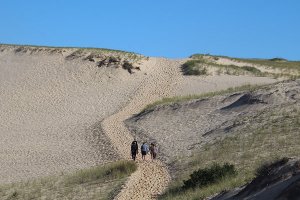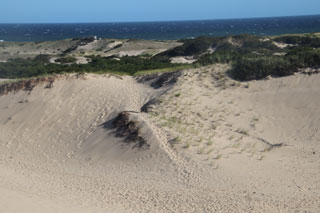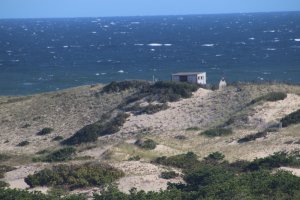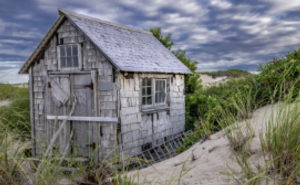The 19 Dune Shacks of the Peaked Hills Bar Historic District
By: Marguerite Wiser
The Dune Shacks of the Peaked Hill Bars Historic District are sure to be a highlight of anyone’s visit to the Outer Cape! Located in the Peaked Hill Bars Historic District,  the Dune Shacks of Cape Cod are unforgettable and the dunes are otherworldly!
the Dune Shacks of Cape Cod are unforgettable and the dunes are otherworldly!
Within the Cape Cod National Seashore, the Peaked Hill Bars Historic District encompasses 1,900 acres of sand dunes, small bogs, and serene coastline dotted with the weathered and historic dune shacks of Cape Cod. Nineteen rustic shacks teeter on the ever-shifting hills and valleys of sand, the historic dwellings of writers, poets, painters, playwrights, and others who came for the solitude and inspiration of this stark and unique environment, just outside of the artists colony of Provincetown.
While many came for and found solitude, a thriving culture of dune dwellers and community of creativity emerged on the ephemeral edge of the continent, from Jackson Pollock, Tennessee Williams, Jack Kerouac, e.e. Cummings, and more. Many of the Dune Shacks of Cape Cod still house artists-in-residence and residencies for those seeking the serenity of the sand and sea, and willing to rough it in the primitive structures.
Prepare to Walk to the Dune Shacks of Cape Cod
The Dune Shacks of the Peaked Hill Bars Historic District and the dunes themselves are best viewed on foot, following the paths of loose sand up and over hills, past low bogs of cranberries, and on to the 

For those who’d rather skip the hike, Art’s Dune Tours guides visitors through the dunes from the comfort of a car, as they have since 1946.
The Logistics of Getting to these Historic Dune Shacks
The Dune Shacks of Cape Cod are a must-see when visiting Provincetown and the Outer Cape. Follow the trailhead from Route 6 (opposite Snail Road) for an otherworldly landscape, beautiful views of the Atlantic stretching to the horizon, and for insight into some of the great artists of the 20th century. The area has limited parking spaces, though visitors tend to park along the road in busy months.
The walk is short but can be strenuous, as the sand is loose and slow-going, and the dunes can be steep. While great in any season, there is no shade to be found on the dunes on hot summer days, so a hat, sunscreen, and lots of water are a must! Many do the walk barefoot, though it’s worth carrying shoes with you, as the sand can get hot in the middle of the day. Checking out the dunes and dune shacks of Cape Cod in the cooler temperatures of the morning and evening is a great way to avoid scorched toes and sunburns, and a perfect way to enjoy some magical golden hour light on the sands.
When walking on the dunes, stay on established paths to protect the fragile dune vegetation. It’s customary to give inhabited dune shacks a polite berth, respecting the artists who have chosen to use the dune shacks of Cape Cod for creative solitude.
The Dune Shacks of Cape Cod can also be reached from the Province Lands Visitors Center.
History of the Dune Shacks of Cape Cod
While much of Cape Cod stabilized under boreal forest after the last ice age, 

The practice of living among these ever shifting dunes began around 1840 with the establishment of life-saving stations, some equipped with boats and men, others with supplies. Shipwrecks had long been a problem on this troublesome coastline. A Parks Service study of the area found an average of 23 wrecks a year in this era. In his 1902 The Lifesavers of Cape Cod, J.W. Dalton commented, “Sunken rips stretch far out under the sea at this place, ever ready to grasp the keels of the ships that sail down upon them.”
The US Life-Saving Service began patrolling beaches in 1872, establishing the Peaked Hill Bars Station (hence the name Peaked Hill Bars Historic District) overlooking a shipwreck and storm prone bit of coastline known as the Graveyard of the Atlantic. The Coast Guard took over the mission in 1918, with Coast Guardsmen and fishermen building additional small dwellings in the area.
Shipwrecks didn’t just bring sailors ashore; the fragrant Salt Spray Rose (Rosa rugosa) is native to Asia and is said to have come ashore with the wreck of the Franklin in 1849. The plant survived, and has thrived, helped along by Coast Guardsmen transplanting them to create cottage gardens around their seaside shacks.
As the 20th century wore on, advances in navigation lessened shipwrecks and the derelict little shacks in the dunes began to catch the eye of artists. Some were drawn to the brilliant light, others to the stark solitude these shacks provided, and still more drawn to the growing collection of dune dwellers led by Eugene O’Neill and Harry Kemp.


The shacks of the Peaked Hill Bars Historic District were linked to families and friends, creating a small but loose-knit seasonal community of dune dwellers and their visitors. Notable visitors included the likes of Jackson Pollock, Tennessee Williams, Jack Kerouac, e.e. cummings, Norman Mailer, Sinclair Lewis, and many more. Other shack owners were not artists, but enjoyed the solitude of the dunes.
A gale in the winter of 1931 swept away several structures, including the life-saving station. This didn’t discourage the dune dwellers who simply salvaged materials and retreated slightly inland to rebuild. The ephemeral nature of the landscape, ever shifting and reforming, extended beyond the sands and into the very structures themselves. All the shacks have been shifted, some moved great distances, renovated, and in some cases rebuilt. Fires, erosion, and sand burial seem to be the main curses of the dune shacks. What stands now as Chanel/Frenchie’s Shack is actually the third shack built on the same spot, with the previous cabins claimed in sandy graves beneath the current iteration. Beyond the sand and the shacks, the dune dwellers have shifted over time as well, with artists and dune lovers growing old and passing their cottages to family and friends.
The Dune Shacks in Recent Times
This line of succession was halted when the Cape Cod National Seashore was formed in 1961 and the National Parks Service began acquiring the land. While the dune dwellers were pleased that their beloved landscape would not be converted to high rises and development, they feared for their weathered little cottages tucked into the dunes.
The 1984 demolition of ‘Dune Charlie’ Schmid’s shack two years after his death proved to be a unifying event for dune dwellers, who banded together to advocate for the preservation of the dune shacks. After careful study the shacks were placed on the National Register of Historic Places, recognizing the importance of their architecture, associations to American arts and literature, and for the legacy of poet Harry Kemp.
The National Parks Service worked out agreements with the shack owners, providing many with lifetime use agreements or yearly permits to occupy the buildings. Others are managed by non-profits who offer residency programs for artists and the public, ensuring the continued tradition of art in the dunes.


Withstanding the Test of Time
The structures continually contend with the harsh elements and require constant upkeep. Eroding dunes threaten to recede from under some shacks, while others are in danger of a dune of sand burying the structure. The dune dwellers and Parks Service have planted native vegetation, installed sand fencing, and employed other methods to stabilize the ever shifting sands. Winter gales and corrosive salt spray also threaten the spartan structures. The fragility and impermanence of existence of the Peaked Hill Bars Historic District has never discouraged the dune dwellers before, and while the seas of a rapidly warming ocean are rising, it’s unlikely that the dune shacks will be abandoned any time soon.
Click here to explore all of the 19 Dune Shacks of the Peaked Hill Bars Historic District.
Enjoy Exploring? Hiking, Biking, Walking & Touring?
Get Cape Cod Xplore Post Alerts!
Directly into Your Inbox








